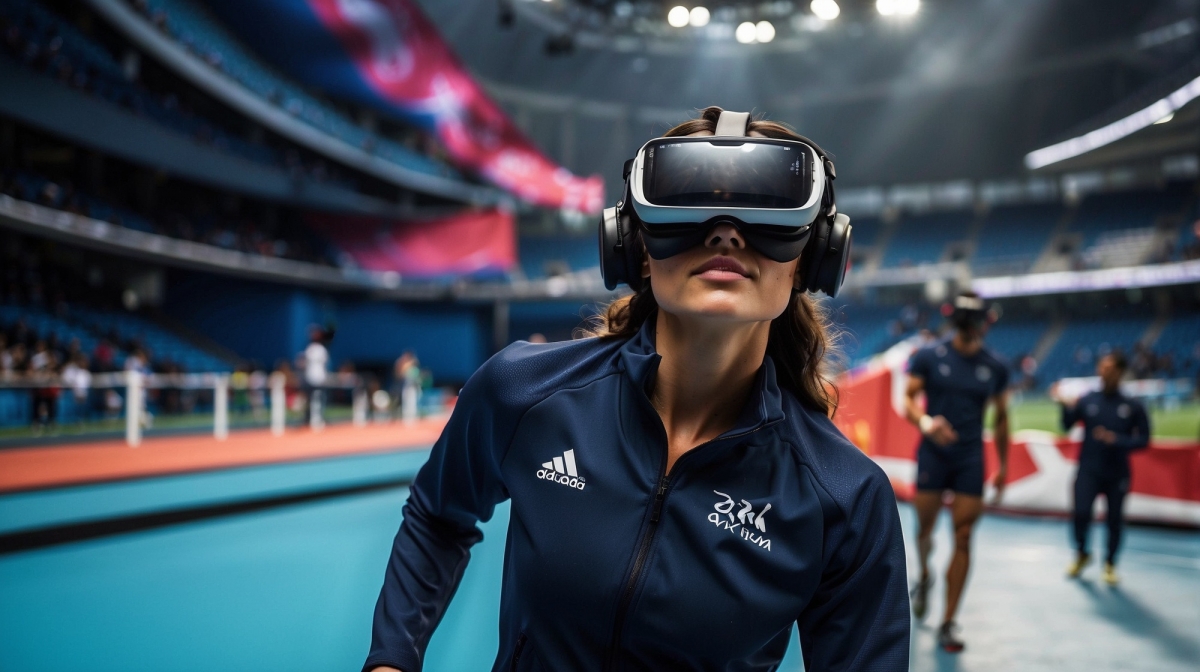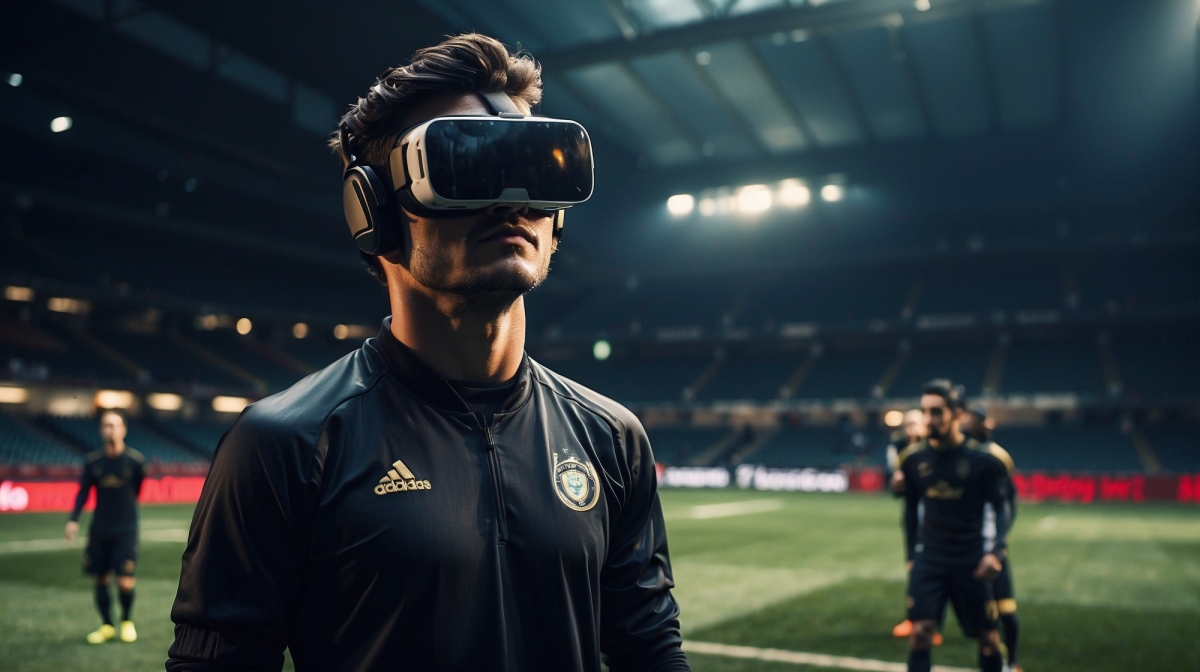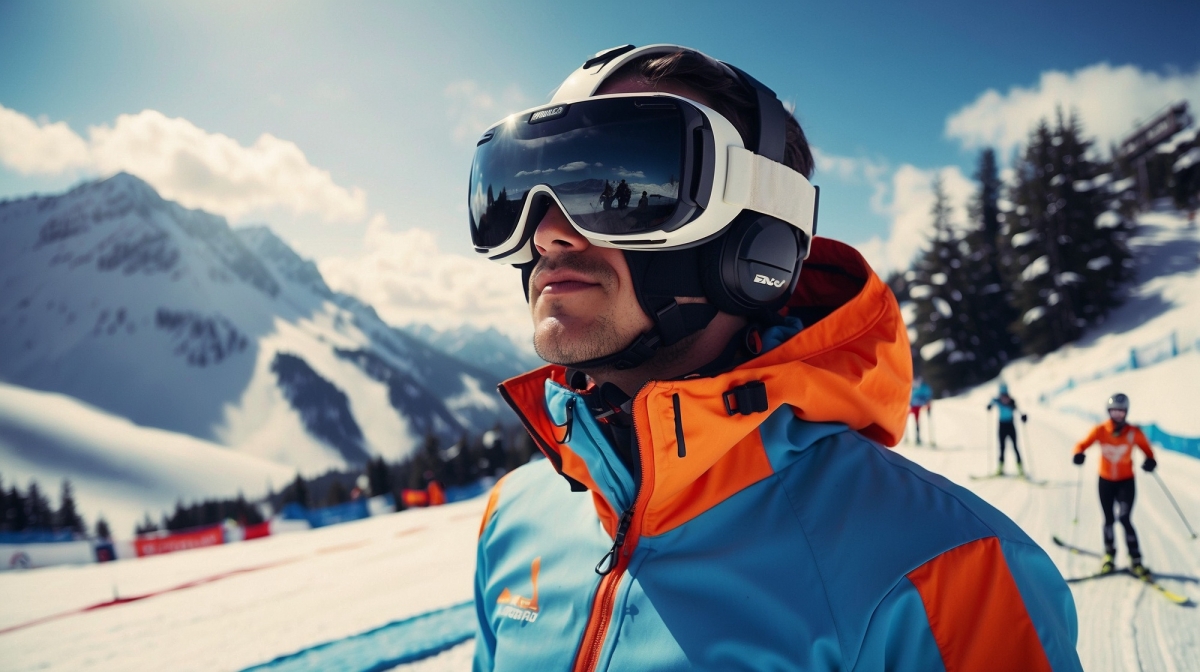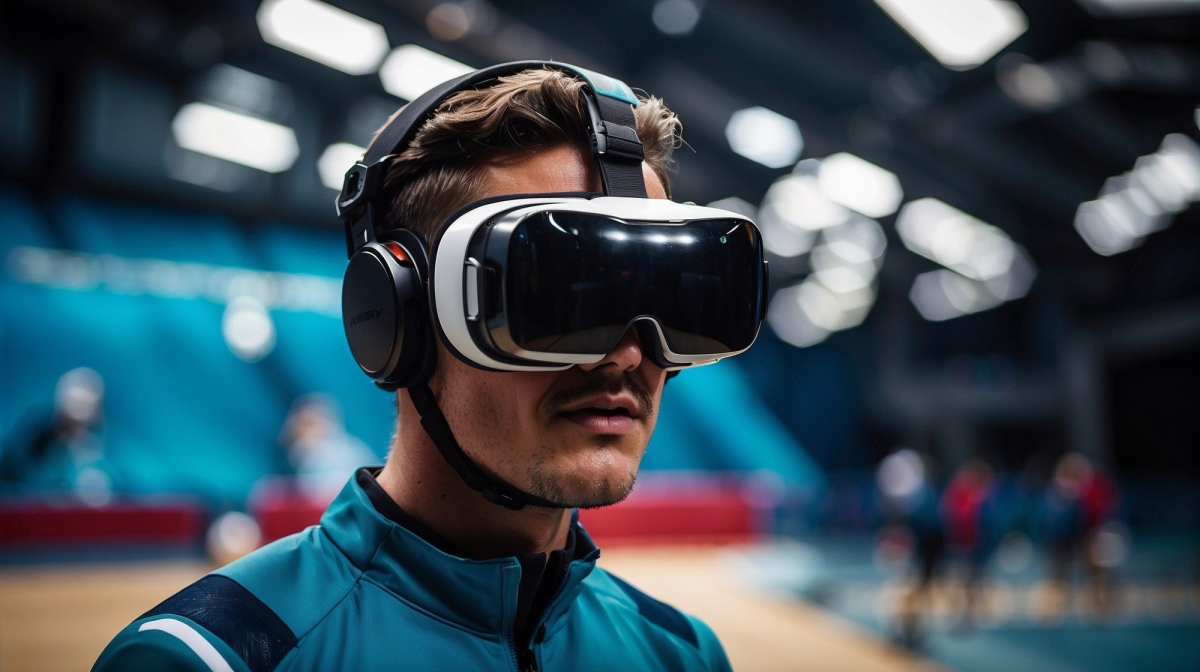Virtual reality training in Olympic sports: Promises and pitfalls
Editor: Ruud den Hartigh; Editorial Assistant: Stella Wernicke, Jana Dreston
This article has also been translated into German, Italian, and Dutch.
The advent of virtual reality technology provides Olympic athletes and coaches with manifold new possibilities for training and competition preparation. Although promising and increasingly backed up by scientific research, it is important to be aware of the limitations and potential pitfalls of applying this new technology to the sports domain.
 Image 1: An Olympic athlete using virtual reality in a stadium (AI-generated).
Image 1: An Olympic athlete using virtual reality in a stadium (AI-generated).
Throughout recent years, the interest in
virtual reality (VR) technology increased tremendously across a broad range of domains (e.g., medicine or military), also including high-performance Olympic sports [1]. In this article, we aim to provide evidence-based insights into the effects of VR training on athletes of Olympic sports. Additionally, examples of sport psychological VR practice will be presented as well as future developments, fields of application, and current limitations will be discussed.
VR describes an experience in a simulated virtual environment. Predominantly, these virtual surroundings are presented via VR headsets (e.g., Oculus/Meta Quest or HTC Vive) with pose tracking and 3D displays right in front of the users’ eyes. Compared to conventional computer screens, VR technology allows users to immerse (i.e., dive) into the virtual environment to a much higher extent, which is arguably caused by
factors such as a realistic
field of view, isolation from the real world, and high-fidelity software. This increased immersion leads to a much more intense and embodied experience as compared to merely "observing" the contents of the video/application on a conventional screen.
With the advent of this modern method, new possibilities of training have arisen in various high-performance sports disciplines. For example, in our ongoing project with the Austrian Ski Association, alpine skiers use VR to re-experience and video-analyze previously run races or to practice upcoming ones in a safe and resource-efficient virtual environment. Moreover, in soccer (or football), VR can be used to train
field players’ awareness on the pitch, for instance, in the form of scanning behavior (i.e., rapid head movements over the shoulder to perceive the surrounding players. Despite not yet being explicitly tested in VR, in real-life, scanning behavior seems to have a positive influence on soccer performance [2].
Another study was conducted using VR goggles to enhance decision-making in junior basketball players [3]. The participants were shown videos of set plays and had to decide which action they would perform next after the clip ended. Players who had been viewing these videos in VR made significantly better decisions on the court than those who had been viewing the plays on a conventional computer screen. For example, the players who did the VR training achieved a higher decision-making accuracy score, particularly for untrained plays that they had not seen before the assessment. This finding indicates both transferability to the real world and better generalizability to novel situations of VR-based training compared to conventional video-based training.
 Image 2: Virtual reality training of a soccer player (AI-generated).
Image 2: Virtual reality training of a soccer player (AI-generated).
These are just a few examples of the many attractive use cases of VR in and between various types of sports. In principle, VR training is potentially interesting whenever it can provide a feasible alternative to physically demanding, dangerous, impractical, or otherwise expensive training situations (with respect to human, technical, or temporal resources) [1].
In recent research, the effects of VR training have been investigated in some initial studies that assessed relevant target skills of the respective sports. Across twelve different pre-post
intervention studies, including various types of sports (e.g., archery or soccer) and sport-unspecific processes (e.g., balancing skills), VR training effects mostly outperformed training effects in control conditions using more traditional approaches [1, 4, 5, 6]. For instance, one study observed higher improvements in passing decision-making performance and visual search behavior for soccer players training in VR compared to a conventional video screen [5].
In addition, first investigations into the long-term transfer effects of VR training were made with baseball players [7]. Those who took part in an
adaptive VR batting training (i.e., pitch speed, type, and location continuously adjusted to the players’ performance) were more likely to compete at least one full season at a level above high school baseball in the five years after the
intervention compared to the other training groups (non-
adaptive VR batting practice, real batting practice, and control). Thus, VR training even outperformed additional real batting practice concerning long-term transfer effects.
These meaningful effects point to the potential of VR to elicit real-life performance increases. Nevertheless, the successful transfer from VR to the real world was observed in a rather heterogeneous set of initial experiments, and it remains unclear if VR
simulations tailored to specific skills (e.g., gaze behavior in soccer) help athletes perform better in the real sport.
Therefore, further studies and – in particular –
independent replications are needed to pave the way for solid evidence-based conclusions concerning the potential benefits of VR training with practical significance [1]. Specifically, researchers should attempt to acquire evidence on whether VR is suited to successfully enhance the (cognitive) skills required in the relevant sport both in the virtual environment (step 1) and in reality (transfer effect; step 2). Ultimately, the most interesting question of whether VR training leads to enhanced performance and the athletes winning more real-life competitions must be investigated more thoroughly in future studies (step 3). In the following section, we will discuss the promising and manifold use cases of VR in Olympic sports in more detail before we highlight some of the potential pitfalls of using this new technology.
 IMAGE 3: An alpine skier using virtual reality on the slopes (AI-generated).
IMAGE 3: An alpine skier using virtual reality on the slopes (AI-generated).
“A new dawn”: Promises of VR training in athletes of Olympic sports
When it comes to VR headsets in general, these are getting more and more affordable and simultaneously better in performance. This comes with better graphics and, in turn, higher levels of immersion. Additionally, VR headsets are becoming increasingly lighter, which leads to an overall better experience using these devices due to less discomfort. Indeed, current VR head-mounted displays are often quite heavy (e.g., 503 grams for the Meta Quest 2 and 515 grams for its successor, the Meta Quest 3), potentially causing discomfort in longer training sessions, as some neck muscle contraction is required by the users to counteract gravity.
Another hardware-specific characteristic that will see changes in the future is the way in which the VR experience is controlled and navigated. Prospectively, it is likely that separate hardware controllers will be completely omitted. Instead, the only navigating system will be the users’ hands, enabling higher comfort as well as more natural finger and hand movement patterns compared with regular handheld controllers. Also, video-based foot tracking could be implemented as opposed to foot controllers that are already used (e.g., in the software Rezzil Index).
To ensure a greater resemblance of real-life sports features, we would speculate that some VR developers might also consider using bodysuits and/or sports equipment with trackers. This could pave the way to an “as close as possible” embodied sports experience in a virtual environment, given that vibrations are implemented in the hardware that simulate real-world sensorimotor sensations. It is questionable, however, if presenting this stimulation is sufficient for the substitution of real-world sensory input.
In sports where making correct decisions is of high importance, VR can be used to explore all the possible outcomes using artificial intelligence (AI). For example, in soccer, players could experiment with different passing or running decisions to find out how this would have changed the outcome of the specific game scenario. AI algorithms could use the information of the time before the point where the decision is made to determine what would most likely happen for each other decision that could have been made.
Implementing this combined method of explicit and implicit learning in a highly stimulating, immersive environment could largely benefit players of various sports in their decision-making. It must be noted, however, that in this example (soccer) and in other sports,
significant space might be required for players to move in during VR training and testing [8, 9, 10, 11].
Moreover, for video analysis in several types of sports, VR holds promising solutions. 360° videos are an excellent tool to use in VR headsets and provide athletes with an immersive experience of their (past and future) sporting performance in both training and competition. Recordings both from an external as well as an internal point of view (POV) might be helpful for athletes to extensively analyze their previous performance and prepare for upcoming situations (such as new sports venues, as is often the case in Olympic Games) using multiple perspectives. The combined analysis of different POVs in VR also enables switching the perspective to e.g., a teammate, a coach, an opponent, or a referee to make it understandable why certain decisions were made given the information that was available from the other POV. In team sports, this could lead to a higher sports-related “Theory of Mind” when players increase their perspective-taking abilities and can plan and react accordingly in training and competition.
Besides VR, there is also the term mixed reality (MR), which can be expected to receive more interest and implementation in the future due to recent developments in this area. MR describes the combination of virtual and real (physical) environments. For example, using a VR headset to generate elements on the display (e.g., a virtual dartboard) that are projected into the real world (e.g., a real wall in a house) captured via cameras on the outside of the headset, can be considered as MR.
For Olympic sports, this means that it could become possible to generate, for instance, an Olympic stadium on your training ground to simulate this important competition in everyday training. This can be regarded as competition preparation as close as possible. Auditory features such as crowd noise can also easily be implemented and serve as realistic characteristics. To exemplify, a track and
field athlete could simulate the Olympic 100 meters sprint race by generating the relevant stadium virtually and running on a real-world track. However, not only the run itself can be used for preparation, but also the time before and after it. Imaginative scenarios and routines can be played through and serve as mental repetitions of possible real-life outcomes.
For high-precision sports, VR can serve as a tool to practice massive repetition of actual movement patterns in a virtual environment with minimal physical demands. For instance, tennis serves, soccer free-kicks, baseball batting, and archery would count to such highly repeatable tasks. No training tool is needed besides the VR hard- and software itself. This makes precision training highly mobile and eliminates the requirement of always carrying your training gear with you and being dependent on the facilities the athletes reside in. Basketball, archery, golf, shooting, squash, tennis, etc. could largely benefit from this possibility of applying VR in that literally carrying your training gear and environment with you and having the opportunity to get realistic extra-repetitions is highly economical and only minimally physically demanding.
Concerning more
domain-general psychological skills, VR offers the training of several mental abilities or strategies that are required for an outstanding performance in Olympic athletes. Learning to perform under pressure, handling pre-performance
anxiety, practicing routines, stress management, and regulating emotions, among others can be practiced using VR devices through commercially available software and self-made 360° videos.
Regarding rehabilitation of injured athletes, VR offers various opportunities for sport-specific (cognitive) skills training and stress reduction [12]. This can be done with only minimal physical demands. For instance, coaches could use stationary sport
simulations, reaction time/decision making drills, or VR-guided mindfulness apps to minimize the movement required from the actors but to preserve their abilities and keep them connected to their sport. Therefore, VR can be implemented in rehabilitation schedules as a riskless alternative compared to learning, practice, and rehearsal of sports activities in real-life.
Lastly, for teams and coaches scattered around the globe, it could be interesting to have team meetings in the “metaverse”. This could be particularly relevant in the context of limited accreditation places for coaching staff at the Olympic Games. Using avatars and simulated meeting rooms would be an interesting experiment for teams to try and seek out potential benefits over conventional video calls in terms of interacting with each other and having a sense of “really being there together”.
 Image 4: Virtual reality training of a track and field athlete (AI-generated).
Image 4: Virtual reality training of a track and field athlete (AI-generated).
The modern solution to everything? Pitfalls of VR training in athletes of Olympic sports
Despite all the possible use cases and potential advantages over common (computer) training methods, some
safety-related
factors must be taken into consideration when applying VR training. The training sessions should not last for longer than 30 minutes without taking breaks and the discrepancy between movements in the virtual and the real world should not be too large to avoid so-called cybersickness, which is a common side effect of VR including e.g., nausea or headaches [13, 14].
Moreover, VR is not (yet) suited to train fine motor skills due to a lack of realism, arguably caused by missing haptic feedback. At the current state of VR devices in terms of performance, using them to train fine motor skills could lead to incorrect re-learning of movement patterns in athletes. To illustrate, an elite ice hockey goalkeeper, who is training with VR under the supervision of the authors, reported maladaptive movement patterns after training with a particular VR software. This is likely to be attributed to an imperfect “pseudo”-realism of this particular VR software and shows that researchers must bear in mind that training in VR might not (yet) be the same as training in the real world. Rather, based on recent evidence, it seems plausible that it can be used to train key points of certain movement patterns or procedural sequences and tactical movements that are less fine-grained, e.g., heading in soccer [15, 16].
Furthermore, another limitation of VR devices is the fact that they should not be used as an immediate warm-up or directly before physical training and competition. During VR training, the users’ eyes receive conflicting depth cues and stress is placed on the visual system due to the unnatural setup (3D vision generated on 2D screens only centimeters away from the users’ eyes). After the VR device is removed, the visual system needs a few minutes to get used to the real world again. Thus, after VR usage it should be considered that oculomotor stability and depth
perception are impaired for a short time frame, possibly impairing real-life performance in visually guided tasks [17].
When it comes to the motivational effects of VR training, it must be noted that repetitive exercises in a standardized environment – despite having certain advantages – can be detrimental to athletes’ long-term motivation. Repeated practice might gradually become monotonous, especially when training alone. Current VR applications still lack the social interaction that is usually occurring on real-life training pitches. Therefore, while VR is suitable for repetitive standardized training in a safe and well-controlled environment, certain aspects of real-life training such as social interaction and generally more sensory input remain missing.
 IMAGE 5: An Olympic athlete using virtual reality in a practice arena (AI-generated).
IMAGE 5: An Olympic athlete using virtual reality in a practice arena (AI-generated).
Conclusions
In sum, VR training enables athletes of various Olympic sports to engage in learning, practice, and rehearsal that in real life can be physically demanding, dangerous, impractical, or otherwise expensive (with respect to human, technical, or temporal resources). We outlined that this new technology comes with many promising possibilities for Olympic athletes, both presently as well as in the future (e.g., preparing for a competition). Nevertheless, some issues remain that must be considered as potential pitfalls of VR training as of now (e.g., missing haptic feedback). With continuous new developments in this area, however, we are certain that this is just the beginning of sport psychological VR (and MR) research and practice and that there is much more to come in the next few years.
Bibliography
[1] F. Richlan, M. Weiß, P. Kastner, and J. Braid, “Virtual training, real effects: a narrative review on sports performance enhancement through interventions in virtual reality,” Frontiers in Psychology, vol. 14, 2023, doi:10.3389/fpsyg.2023.1240790
[2] G. Jordet, K. M. Aksum, D. N. Pedersen, A. Walvekar, A. Trivedi, A. McCall, A. Ivarsson and D. Priestley, “Scanning, Contextual Factors, and Association With Performance in English Premier League Footballers: An Investigation Across a Season,” Frontiers in Psychology, vol. 11, 2020, doi:10.3389/fpsyg.2020.553813
[3] C. Pagé, P. Bernier and M. Trempe, ”Using video simulations and virtual reality to improve decision-making skills in basketball,” Journal of Sports Sciences, vol. 37, no. 21, pp. 2403–2410, 2019, doi:10.1080/02640414.2019.1638193.
[4] D. Bedir and S. E. Erhan, “The Effect of Virtual Reality Technology on the Imagery Skills and Performance of Target-Based Sports Athletes,” Frontiers in Psychology, vol. 11, p. 2073, 2020, doi:10.3389/fpsyg.2020.02073
[5] L. S. Fortes, S. S. Almeida, G. M. Praça, J. R. A. Nascimento-Júnior, D. Lima-Junior, B. T. Barbosa and M. E. C. Ferreira, “Virtual reality promotes greater improvements than video-stimulation screen on perceptual-cognitive skills in young soccer athletes,” Human Movement Science, vol. 79, p. 102856, 2021, doi:10.1016/j.humov.2021.102856.
[6] O. Köyağasıoğlu, C. Özgürbüz, C. Ş. Bediz, Ç. Güdücü, R. Aydınoğlu, T. Akşit, “The Effects of Virtual Reality Nonphysical Mental Training on Balance Skills and Functional Near-Infrared Spectroscopy Activity in Healthy Adults”, Journal of Sport Rehabilitation, vol. 31, no. 4, pp. 428–441, 2022, doi:10.1123/jsr.2021-0197
[7] R. C. Gray, “Transfer of Training from Virtual to Real Baseball Batting”, Frontiers in Psychology, vol. 8, 2017, doi:10.3389/fpsyg.2017.02183
[8] B. R. Fajen, G. Díaz and C. M. Cramer, “Reconsidering the role of movement in perceiving action-scaled affordances,” Human Movement Science, vol. 30, no. 3, pp. 504–533, 2011, doi:10.1016/j.humov.2010.07.016.
[9] P. W. Fink, P. Foo and W. H. Warren, “Catching fly balls in virtual reality: A critical test of the outfielder problem,” Journal of Vision, vol. 9, no. 13, p. 14, 2009, doi:10.1167/9.13.14.
[10] F. T. J. M. Zaal and R. J. Bootsma, “Virtual Reality as a tool for the study of Perception-Action: the case of running to catch fly balls,” Presence: Teleoperators & Virtual Environments, vol. 20, no. 1, pp. 93–103, 2011, doi:10.1162/pres_a_00037.
[11] F. T. J. M. Zaal and C. F. Michaels, “The information for catching fly balls: Judging and intercepting virtual balls in a CAVE. Journal of Experimental Psychology: Human Perception and Performance,” vol. 29, no. 3, pp. 537–555, 2003, doi:10.1037/0096-1523.29.3.537.
[12] M. Weiß, M. Büttner and F. Richlan, “The role of sport Psychology in injury prevention and rehabilitation in junior athletes,” Behavioral Sciences, vol. 14, no. 3, p. 254, 2024, doi:10.3390/bs14030254.
[13] K. Nesbitt and E. Nalivaiko, “Cybersickness,” in Encyclopedia of Computer Graphics and Games, N. Lee, Ed., Springer International Publishing, 2018, pp. 1–6, doi:10.1007/978-3-319-08234-9_252-1.
[14] N. A. Webb and M. J. Griffin, “Eye movement, vection, and motion sickness with foveal and peripheral vision,” Aviation, Space, and Environmental Medicine, vol. 74, no. 6, pp. 622–625, 2003.
[15] B. Marshall, L. Uiga, J. V. V. Parr and G. Wood, “A preliminary investigation into the efficacy of training soccer heading in immersive virtual reality,” Virtual Reality, vol. 27, no. 3, pp. 2397–2404, 2023, doi:10.1007/s10055-023-00807-x.
[16] J. V. V. Parr, L. Uiga, B. Marshall and G. Wood, “Soccer heading immediately alters brain function and brain-muscle communication,” Frontiers in Human Neuroscience, vol. 17, 2023, doi:10.3389/fnhum.2023.1145700.
[17] D. J. Harris, G. Buckingham, M. R. Wilson, J. Brookes, F. Mushtaq, M. Mon-Williams, and S. J. Vine, “The effect of a virtual reality environment on gaze behaviour and motor skill learning”, Psychology of Sport and Exercise, vol. 50, pp. 101721, 2020, doi:10.1016/j.psychsport.2020.101721.
Images
Created with Leonardo.Ai (https://leonardo.ai/)


